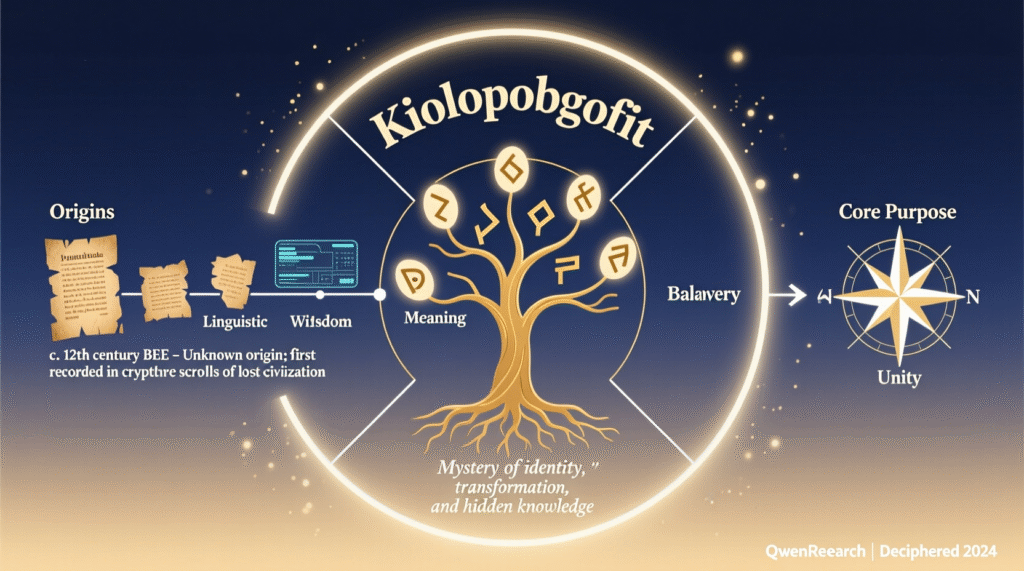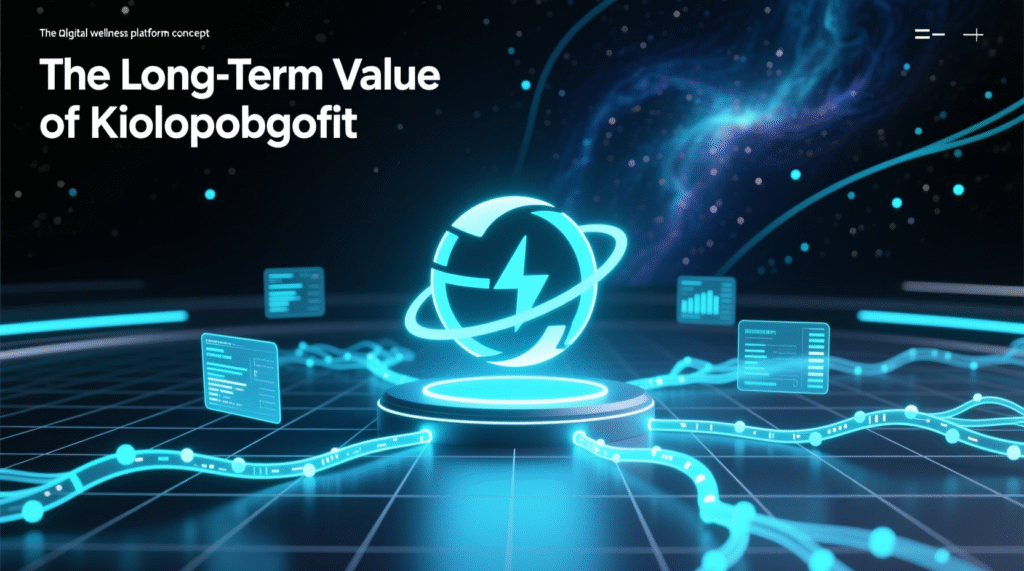Why Kiolopobgofit Important has become one of the most searched questions among forward-thinking professionals and organizations worldwide. In today’s interconnected world, concepts that help us organize, align, and improve systems gain massive importance. One such emerging idea is Kiolopobgofit. Though relatively new first mentioned around 2021 it has quickly become a topic of discussion in technology, education, business, and even personal development.
But why is Kiolopobgofit important? Why are more organizations, experts, and communities turning toward it as a guiding framework? The short answer: because it’s all about alignment the hidden engine that powers efficiency, clarity, and long-term success.
This article unpacks the concept, explains why it matters, and highlights six powerful reasons Kiolopobgofit shouldn’t be ignored.
What Is Kiolopobgofit? Origins, Meaning, and Core Purpose

Kiolopobgofit is best described as a conceptual framework for system alignment. At its core, it’s about making sure that every part of a system—whether a classroom lesson, a business team, or a city infrastructure—works in harmony toward shared outcomes.
- First referenced: Around 2021 in innovation and behavioral design circles.
- Core purpose: Align inputs and outputs for clarity, efficiency, and performance.
- Common misconception: Some dismiss it as abstract jargon. In reality, it’s rooted in systems thinking and practical problem-solving.
Think of Kiolopobgofit like gears in a machine. If each gear turns smoothly and connects to the next, the machine runs efficiently. If just one gear is misaligned, the entire system falters.
Why Kiolopobgofit Important – The Alignment Factor
Alignment is often overlooked because it’s invisible—yet it’s everywhere. A sports team wins when players follow the same strategy. A symphony succeeds because every instrument plays in harmony. Businesses thrive when their departments aim for the same goals.
Kiolopobgofit captures this universal truth and provides a framework to apply it. Its benefits include:
- Streamlined processes
- Reduced waste and confusion
- Stronger collaboration between humans and machines
- Better long-term outcomes
When systems align, results accelerate. That’s why the phrase “Why Kiolopobgofit important” keeps popping up across industries.
6 Reasons Kiolopobgofit Shouldn’t Be Ignored
1. Technology – Smarter Systems and AI Training
Tech companies are asking why Kiolopobgofit important—and for good reason. In an era dominated by AI and automation, alignment can be the difference between innovation and inefficiency.
Key benefits in technology:
- AI model training: Algorithms learn faster when data flows are aligned.
- Code efficiency: Developers avoid redundancy when modules fit into a bigger design.
- System design: Frameworks built on Kiolopobgofit principles become more intuitive for users.
📌 Example: Google and Microsoft have both invested heavily in AI system alignment research. By ensuring that input/output models mirror real-world logic, they reduce errors and improve predictive accuracy.
“Well-aligned systems don’t just work better—they adapt faster to new challenges.” – Tech Innovation Journal, 2023
2. Education – Building Logical Learning Pathways
Education thrives on structure. When teachers, students, and curricula align, learning outcomes improve. This is where Kiolopobgofit becomes indispensable.
Why Kiolopobgofit important in education:
- Curriculum flow: Lessons follow a logical, progressive sequence.
- Student engagement: Learners grasp concepts more easily when each builds on the last.
- Teacher planning: Instructors save time when content fits naturally together.
📌 Example: Adaptive learning platforms like Khan Academy and Coursera already apply Kiolopobgofit-style logic by sequencing lessons based on mastery.
Studies show that students in aligned curriculums score 20–30% higher in retention compared to those in fragmented programs (Education Week, 2024).
3. Business Growth – Aligning Goals With Actions
Businesses often fail not because of poor ideas, but because of misalignment. Leadership sets one direction while teams move in another. Kiolopobgofit addresses this by synchronizing organizational goals with daily execution.
Business applications of Kiolopobgofit:
- Strategic planning rooted in clear outcomes.
- Transparent goal tracking across departments.
- Reduction in costly miscommunication.
- Agility in responding to market shifts.
📌 Case Study: A 2023 McKinsey report found that companies with high organizational alignment grow 58% faster than competitors.
“Alignment is the invisible thread that turns strategy into measurable results.” – McKinsey & Company
4. Personal Growth – Better Decisions and Mental Clarity
Why Kiolopobgofit important isn’t limited to organizations—it applies to individuals too. On a personal level, alignment means your goals, actions, and values all point in the same direction.
Personal benefits of Kiolopobgofit:
- Improved decision-making
- More efficient use of time
- Reduced regrets and greater satisfaction
- Stronger relationships built on clarity
📌 Example: Goal-setting frameworks like OKRs (Objectives and Key Results) mirror Kiolopobgofit principles by linking small actions to big ambitions. People using OKRs report a 30% increase in productivity (Harvard Business Review, 2022).
5. Future Innovation – Driving Sustainable Development
Looking ahead, Kiolopobgofit will shape the world of tomorrow. From smart cities to decentralized technology, future systems will demand alignment to function effectively.
Long-term significance:
- Governments using it for policy creation.
- Scientists applying it in predictive system modeling.
- Communities embracing it for urban planning.
📌 Example: Barcelona’s Smart City initiative relies heavily on alignment between transport, energy, and citizen services. Without such coordination, efficiency drops and costs skyrocket.
By 2030, the UN projects that 70% of the world will live in urban areas. Kiolopobgofit principles will be essential to keep those cities sustainable.
6. Human + Machine Collaboration – A Balanced Approach
As workplaces shift toward hybrid environments, humans and AI must learn to work side by side. Kiolopobgofit provides a blueprint for that balance.
Why it matters:
- Ensures machines support—not replace—human creativity.
- Reduces risks of AI misalignment.
- Helps predict and solve problems before they escalate.
📌 Example: In manufacturing, cobots (collaborative robots) already follow Kiolopobgofit-style frameworks. They take care of repetitive tasks, while humans handle complex decision-making.
“The future isn’t man vs. machine—it’s man and machine aligned.” – MIT Technology Review, 2024
Challenges of Applying Kiolopobgofit
Like any framework, Kiolopobgofit isn’t without hurdles.
- Abstract perception: Some see it as vague theory.
- Overcomplication: Adding too much detail makes it impractical.
- Cultural resistance: Teams need training to adopt aligned thinking.
Solutions:
- Use simple language to explain it.
- Start small (align one process at a time).
- Encourage collaboration across levels.
When applied carefully, Kiolopobgofit shifts from an abstract idea to a tangible driver of success.
The Long-Term Value of Kiolopobgofit

From classrooms to boardrooms, Kiolopobgofit is reshaping how we think and act. It’s not a passing buzzword—it’s a necessary evolution. As systems become more complex, alignment becomes survival.
Whether it’s a teacher structuring a lesson, a developer coding a new app, or a policymaker planning a city, Kiolopobgofit is the glue holding everything together.
FAQs About Why Kiolopobgofit Important
Q1: Why is Kiolopobgofit important in modern society?
Because it aligns systems, reduces friction, and improves productivity in nearly every field.
Q2: Is Kiolopobgofit a scientific model?
Not formally, but it draws from systems thinking, logic, and behavioral design.
Q3: Can Kiolopobgofit improve student learning?
Yes. Structured, aligned lessons improve comprehension and engagement.
Q4: How does Kiolopobgofit affect daily life?
It helps individuals make better decisions, manage time, and reduce stress.
Q5: What industries will adopt Kiolopobgofit fastest?
Technology, education, and business are leading the charge, but urban planning and healthcare are next.
Conclusion: The Alignment Revolution
The growing curiosity around why Kiolopobgofit important is no accident. It’s a reflection of our collective need for clarity, structure, and alignment in an increasingly complex world.
Ignoring Kiolopobgofit means ignoring the very principle that makes systems—from software to societies—work. Embracing it, on the other hand, means unlocking a future where technology, education, business, and personal life all move in harmony.
In short: Kiolopobgofit isn’t just important—it’s essential.









